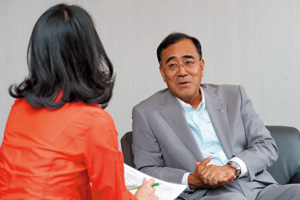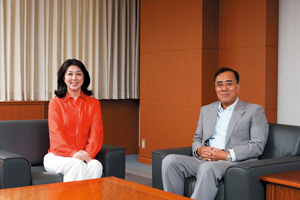 |
|
|
|
|
|
View from the Top Vol. 9, No. 11, pp. 1–4, Nov. 2011. https://doi.org/10.53829/ntr201111tp1  Refining Our Business, Technical, and Personnel Capabilities during Normal Times to Build Reliable Facilities Robust to DisastersOverviewJust as NTT WEST had begun to formulate a new network vision for the future, the Great East Japan Earthquake of 2011 struck the Tohoku region of Japan. What light has this unprecedented disaster shed on the mission of NTT WEST? We sat down with Kouichi Takahatake, Executive Vice President of NTT WEST, to hear how personnel development and a new perspective on network facilities are essential to building a network robust to disasters. Personnel development as a foundation for the future—Mr. Takahatake, could you first brief us on the business conditions surrounding NTT WEST? Of course, but first let me start with some historical background. When NTT was reorganized into NTT Holding Company, NTT EAST, NTT WEST, and NTT Communications in 1999, only NTT WEST was losing money. I suspect that at that time many people had no wish to work at a company engulfed in red figures, but it’s precisely because NTT WEST was in the red that I wanted to work there. I have worked there since then, and I feel that I have grown in parallel with the company’s growth. NTT WEST continued to be in the red from its founding in 1999 until 2002, and while business conditions then recovered owing to a restructuring, they gradually headed downward again with the trend toward decreasing revenues, and profits hit bottom about two years ago. In the last couple of years, however, we have been able to turn things around and show an increase in earnings since 2010. For fiscal year 2011, our objective is to achieve a net increase of 850,000 FLET’S Hikari subscribers and make a single-year profit in our optical connection services. —What would you say were the main reasons for this turnaround in the last few years? Well, the first recovery that I mentioned came about because of restructuring, but I would attribute this recent turnaround to nothing short of corporate abilities. Specifically, the construction of an optical infrastructure and sales of optical services have had a great impact in addition to the fact that all employees have played their part in reducing costs. I believe that fiscal year 2011 will mark a new chapter in the history of NTT WEST. —What were your specific strategies for making a single-year profit in optical connection services? My primary strategy was to enhance personnel development. In this regard, I mention here that my duties in a previous position as manager of Personnel Department No. 2 included the duties of a personnel-development manager as well as the ordinary duties of a personnel manager. At that time, NTT WEST had two major objectives: completely migrating from the telephone era to the Internet protocol (IP) era and achieving a turnaround from red to black in company earnings. Out of these objectives came a simple, straightforward business policy. Let me explain. Achieving these objectives was directly connected to people and skills. In other words, I felt that these objectives could be achieved by enriching our human resources. For example, making the shift from conventional telephone services to IP required personnel and engineers skilled in both technologies. Thinking that we had to raise the existing skills of our personnel to a higher level, I therefore embarked on a path of personnel development. Specifically, I created a system for training engineers, a mechanism for educating employees, by analyzing and organizing the skills that would be needed and assembling them into a booklet as a training program. Advanced IP engineers currently number more than 3700. This figure in itself reflects the extent of personnel training at NTT WEST. My plan is to continue with these educational and training activities so that we can continue to produce highly knowledgeable and professional personnel. Looking back, NTT WEST has come to grow on the basis of three strategies: (1) business strategy, or the company’s business policy; (2) technology strategy, or the technology required to execute the business strategy; and (3) human resources strategy, or the training of personnel to execute the technology strategy. Specifically, we established the telephony-to-IP transition as a business policy, clarified the technologies needed to execute that policy, and proceeded to develop personnel knowledgeable in those technologies and assign them appropriately. NTT WEST has grown by creating a well-balanced tripod formed by these three strategies. This process took patience, but taking one step at a time led to the present results.
Up-close communication training—What is the feeling that drives your step-by-step approach to leadership? As a general rule, the bigger an organization becomes, the slower it moves. Needless to say, NTT WEST is not a small company. With such a large staff, I believe that nothing will change unless I take it upon myself to get the ball rolling. To this end, I think along the lines of my future lies in continual change, and now is the time to decide my future. Doing something on the basis of what someone else says is not interesting at all; what’s important is to take action on one’s own. To give an example, I hold a morning meeting every day. When I first became a section chief about 25 years ago, I made it a practice to hold a face-to-face meeting with my staff every morning except when I could not meet them because of a business trip or other reasons. Since we are a communication service company that places great importance on communication, it made sense that we ourselves should have superb communication skills. Accordingly, to stimulate communication as well as to provide practical training in it, I arranged that the meeting’s participants could exchange information effectively by feeling each other’s presence up close. To be sure, a video conference can also provide a means to communicate, but only after one has mastered direct, face-to-face communication, will it become possible to recognize those aspects of video conferencing that prevent participants from developing a real feel for each other. Without this sense of contact, I think that communication can be difficult. However, no matter how intimate communication may be or how confident speakers may be that they have communicated well, it is not unusual that their intentions are still not conveyed exactly as they would wish. That is why I have made it a practice to hold a meeting every morning. Some people might think that during very busy periods, this simply adds an additional burden, but I believe that it works. The participants become able to sense if someone has a problem just by sitting together at the meeting.
Migrating existing facilities using lessons learned from the Great East Japan Earthquake—This year, Japan experienced an unprecedented disaster in the Great East Japan Earthquake. Wasn’t this an event of great significance for NTT WEST too? It certainly was—this event provided many lessons for us. About two years ago, we began to consider what we could do to enhance people-to-people communications, to promote the evolution of people-to-things communications, and to broaden and deepen the business possibilities of people-to-neighborhood communications. In any case, it’s people-to-people communications that all forms of communication revolve around. This has been NTT’s core axis up to now, but to promote the evolution of communications, we felt the need to modify somewhat our approach to business and the way we configured our project teams. For example, we had been thinking that the need to form alliances with companies in a variety of fields was becoming stronger than ever—and then the earthquake struck. Given the unexpected scale of the resulting damage, this event revealed our strengths and weaknesses for dealing with emergencies. The Great East Japan Earthquake was of the plate-boundary (ocean) type as opposed to an inland type. It featured slow oscillations and generated a tsunami as well. As a result, the damage it caused was of a different type to that of the Great Hanshin-Awaji Earthquake of 1995. In Iwate prefecture, Rikuzentakata was one city that suffered much damage from the earthquake, but the NTT building somehow survived. Amid wide-spread devastation, the building remained standing! When I visited this building, the feeling that arose in me was that all of our past research efforts at NTT had not been made in vain. I walked up to the roof, and while all I could do was put my hands together in a gesture of prayer as I surveyed the surrounding damage, I instantly realized that having strong NTT buildings was the starting point for migrating to future facilities robust to disasters. It goes without saying that NTT buildings should be constructed in safe places. But there are some situations in which all requirements cannot be met. In these cases, it is necessary to consider measures appropriate for the environment in question, such as installing covers on windows. On assessing the damage from this disaster, we were able to clearly determine the weak points of each type of facility and region. It is my desire to reflect all of the lessons that we learned here in future facilities. —Could you tell us how you plan to achieve this migration of existing facilities? The plans that we conceived before the earthquake and the lessons we learned from it indicate that we should convert the network to a full-IP system that can provide a wide array of services. We should also aim for all-optical access and further cost reductions. We also feel that an NTT exchange (building) should be more than just a datacenter; it should also provide value in the form of a smart community center that acts as a base for the entire district. This does not mean that new facilities will be created while completely ignoring existing ones. Though easy to talk about, determining how to make good use of facilities that we have deployed to date, how to merge them with new facilities, and what to change about them form a very difficult problem. There is another valuable lesson that we learned here: it’s important that we refine our skills as much as possible during normal times. In this way, every employee will be able to demonstrate his or her full capabilities at the time of a crisis such as the one we recently experienced. It’s inevitable that crisis management will tend to slacken off when peaceful conditions continue. But the skills and strengths that can be manifested fully only at the time of an emergency can also be tapped in everyday work, and it is with this in mind that I wish to be mentally prepared through ongoing refinement of our individual skills. Now is the time to decide our future. —Mr. Takahatake, could you leave us with some words on what you expect from the R&D department? First of all, I would like to express my deep respect for NTT’s research and development (R&D). Although I did not come out of the laboratories, I have always been interested in people-to-people communications and have often thought that perhaps that was a technology that I should have taken up. NTT researchers study the five human senses and research many interesting and useful themes such as how to read emotions. While I was manager of the NTT WEST Kumamoto Branch, I sometimes took important customers to NTT laboratories to show them some of this cutting-edge, creative research and introduce NTT’s technical expertise to them. Thanks to the energetic efforts of everyone at NTT laboratories, we have been able to increase the number of NTT fans. I also remember how NTT researchers stayed up all night at the time of a major problem with the Hikari Denwa optical phone service to find the cause. I sincerely appreciate the way that NTT laboratories support the daily business activities of NTT Group companies. Finally, I would say to everyone in NTT’s laboratories that I expect you to continue being world leaders in a variety of R&D fields.
Interviewee profileCareer highlightsKouichi Takahatake graduated from the Department of Electrical Engineering and Computer Science, School of Engineering, Kyushu University in 1978 and entered Nippon Telegraph and Telephone Public Corporation (now NTT) in the same year. At NTT WEST, he served as Manager of the NTT WEST Kumamoto Branch, Manager of Network Operations, Senior Vice President and Executive Manager of the Service Management Department, and Senior Vice President and Executive Manager of the Network Department before taking up his present position in June 2011. |
|










